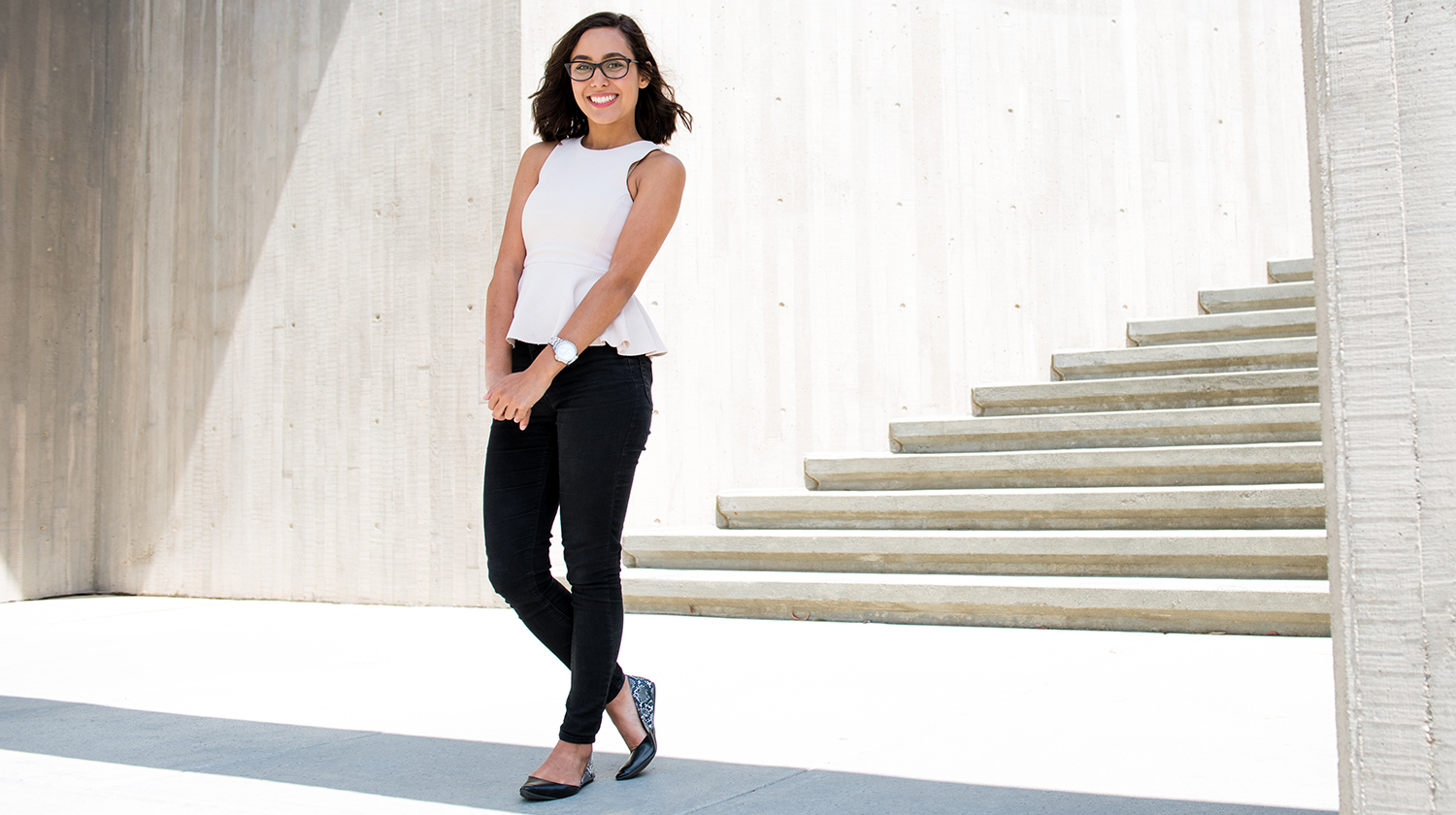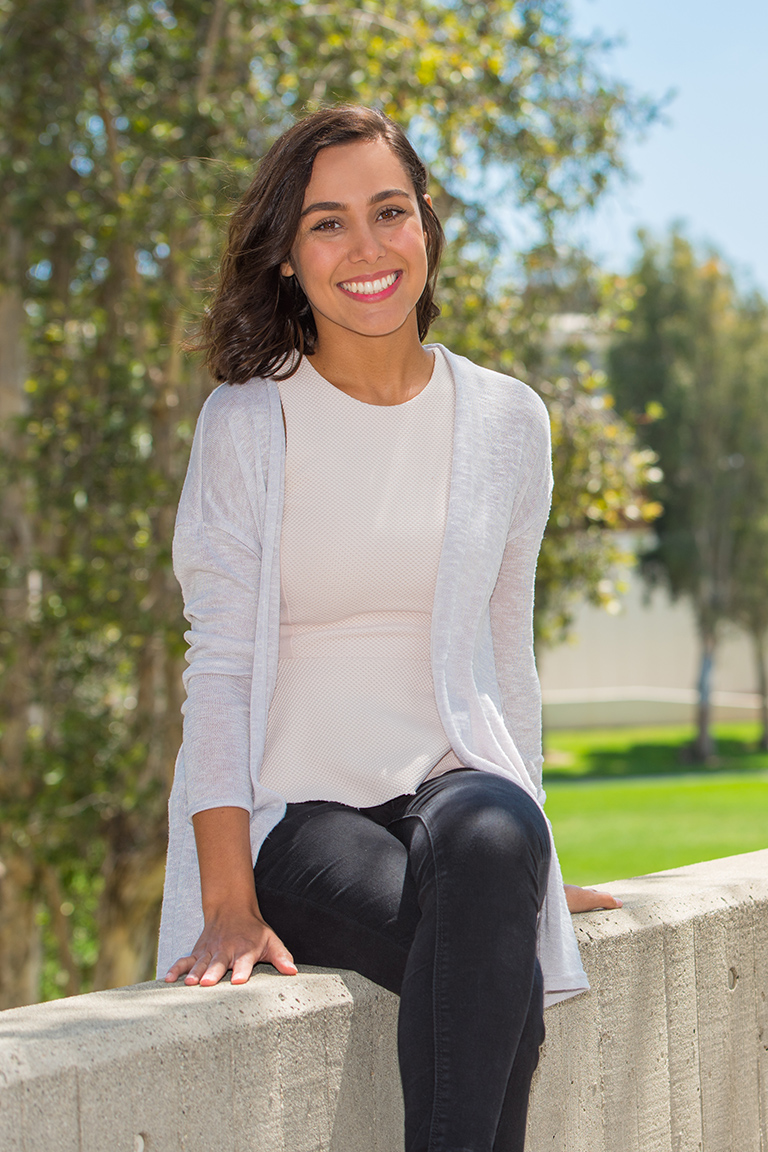 Walking through the “Becoming Los Angeles” exhibit at the Natural History Museum of Los Angeles where she works, Cambria Rodriguez came across a small box labeled “Dead Man’s Island: Demolished in 1929,” which contained several artifacts.
Walking through the “Becoming Los Angeles” exhibit at the Natural History Museum of Los Angeles where she works, Cambria Rodriguez came across a small box labeled “Dead Man’s Island: Demolished in 1929,” which contained several artifacts.
Intrigued, Rodriguez, a history major who graduates with her bachelor’s degree this spring, began looking into the history of the tiny island at the entrance of San Pedro Harbor. The former island whose ominous name was given for the human remains buried there in the 1800s, was demolished to make way for the expansion of Los Angeles Harbor because many sea-going vessels had run ashore on the island.
“I thought ‘What? There was an island there?’ When I started doing research about the island’s demolition and history, I began learning how negatively it affected communities that were here back then,” said Rodriguez. “That really sparked my interest, which grew as I discovered even more about the effects of the massive Anglo migration to the region at the time. It was so surprising to me that it became the main focus of my senior research paper.”
Cambria Rodriguez, who carries a 3.8 GPA and will graduate summa cum laude, will receive her Bachelors of Arts in History as one of the Class of 2018’s nearly 4,000 graduates.
Titled “Bringing Wealth and Water to the City of Angels: Transforming Los Angeles’ Physical Landscape into an Anglo Vision 1885-1930,” Rodriguez entered her research in CSUDH’s 2018 Student Research Day (SRD) competition, where she took 1st place in the Humanities and Letters II category. The win qualified her to apply to present her research during the 32nd Annual California State University Student Research Competition, held May 4-5 at CSU Sacramento, where she again grabbed 1st place for her comprehensive work.
 “I was really surprised and shocked. When they called my name in Sacramento and put it up on the big screen it was hard for me to hold back tears,” said Rodriguez, who was encouraged to submit her research by her history adviser and SRD faculty mentor Doris Namala, a colonial Latin American historian at CSUDH. “When I was walking up the announcer laughed because I stopped and took a picture of my name on the screen. I just thought it was the coolest thing ever.”
“I was really surprised and shocked. When they called my name in Sacramento and put it up on the big screen it was hard for me to hold back tears,” said Rodriguez, who was encouraged to submit her research by her history adviser and SRD faculty mentor Doris Namala, a colonial Latin American historian at CSUDH. “When I was walking up the announcer laughed because I stopped and took a picture of my name on the screen. I just thought it was the coolest thing ever.”
Rodriguez’s award-winning research delves deep into the wide-scale alteration of the Los Angeles region’s natural landscape, which along with the building of the Port of Los Angeles included the rechanneling of the L.A. River, and the building of the Owens River Aqueduct to make L.A. more economically profitable. Her work also provides extensive details–largely ignored by academic researchers to this day–into how the wide-spread changes negatively affected indigenous communities in the area.
“All the changes caused a lot of environmental issues that we still deal with today, and severely affected the communities in the region,” Rodriguez explained. “The Mexican and indigenous people’s knowledge was heavily exploited by developers during the planning, and a land act was initiated that made their land grants nonexistent since they didn’t have the right legal paperwork to hold onto it.”
Much of Rodriguez’s research took place in CSUDH’s Donald R. & Beverly J. Gerth Archives and Special Collections Department.
“The archives were my home when I had any free time. It’s an incredible resource,” she said. “I also looked at people’s diaries to get first-hand accounts, newspaper articles, and lots of photos, postcards, maps, and even some old Hollywood films that were made during the time. Just a huge array of primary sources.”
Rodriguez’s research was so extensive that one of the SRD judges who evaluated her presentation advised her to seek others whose work could benefit from her findings.
“A judge on the panel recommended that I get in contact with people who work on the Los Angeles River Revitalization project and other beautification projects,” she said. “She thought I might even have some useful information that could be helpful to their planning for the river. It was also recommended that I contact a professor at UCLA who is doing similar research in Mexico.”
Rodriguez credits her overall experience on campus and Namala’s mentorship for a lot of the success she has experienced at CSUDH.
“Doris was there to help me all the way, from the outline to the finished product, and getting it ready to be published in the Toro Historical Review with advice about how to improve it. She’s a huge part of this research, and in motivating me to continue doing the work,” Rodriguez shared. “The campus community here is just very comforting. It helps when you see people who look like you and are successful. That’s motivation in itself. I owe all my success to the faculty and staff for motivating me and pushing me out of my comfort zone.”
Unfortunately, Rodriguez will not be joining her fellow graduates at CSUDH’s 2018 commencement ceremony May 18-19. She left for Tanzania three days prior to do six weeks of field work in the African country. Sponsored by the University of Indiana, she will be working at the Olduvai Gorge Museum, located at one of the most important paleoanthropological sites in the world. The museum will process the fossils she and her peers unearth.
“I really enjoy this kind of work, and I want to work around the world. I also want to go to graduate school to study archaeology and museum studies, and eventually earn a doctorate,” Rodriguez said. “Doing research and working for a museum is also what I’d like to do as a career, as well as teach at the college level, kind of like Indiana Jones. That is what I tell people. Of course, it won’t be as romanticized.”